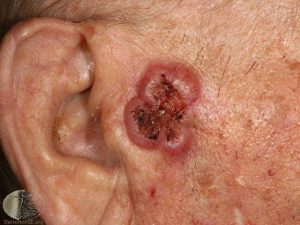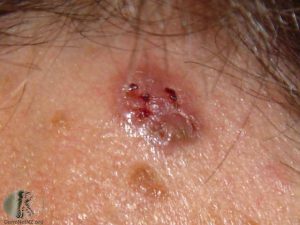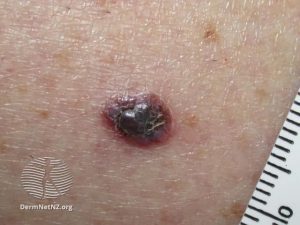
Skin cancer is very common and can occur in people of all ages. There are different kinds of skin cancer. Some types are more common than others, and some have the potential to be more dangerous than others. Sun exposure is a common risk factor for most types of skin cancer, but even areas of the body that do not get sun exposure can develop cancer. It can appear under a nail, on the genitals, inside your mouth, in the back of your eye, or on your lip.
Skin cancer is one of the easiest types of cancer to find in most cases since it can be seen when it appears. Checking your skin to help find a cancerous growth early is important because it is often highly treatable if found early. It is important to look closely at all of your skin and to have a friend or partner check your back and scalp, and the most important thing to notice is any change or new growths on the skin. Characteristics of a skin cancer may include:
- A new or changing mole, especially if it looks different than your others
- A pink, shiny, dome-shaped growth
- A red, scaly patch
- A sore that is painful, itchy, burning, growing, or just not healing
- A brown or black streak in a nail

If you are concerned about a new, changing, or non-healing spot on your skin, it is recommended that you see your dermatologist right away. In most cases, skin cancer is easier to treat when caught early, and it is often harder to treat or more concerning if allowed to grow for too long. A dermatologist may be concerned about skin cancer right away by looking, but proper diagnosis always requires a skin biopsy. All or part of the skin growth may be removed by your dermatologist for examination under the microscope by a highly trained pathologist, and often a second treatment is required after the biopsy depending on the information it provides. Depending on the type of cancer, treatment may be very simple and localized to the area of growth on the skin, or it may be more involved and aggressive. Some treatments are surgical, some include a topical medication, and some involve chemotherapy if an aggressive skin cancer has spread. The following are common forms of skin cancer, each with different standards for treatment:

We are highly trained to provide you with the appropriate diagnosis and treatment for skin cancer. Although much of the sun exposure risk for a new skin cancer has likely occurred earlier in life, we highly recommend regular and appropriate use of sunscreen, sun protective clothing, and avoidance of direct midday sun as much as possible.
